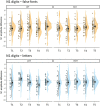Visual Occipito-Temporal N1 Sensitivity to Digits Across Elementary School
- PMID: 35959243
- PMCID: PMC9360418
- DOI: 10.3389/fnhum.2022.887413
Visual Occipito-Temporal N1 Sensitivity to Digits Across Elementary School
Abstract
Number processing abilities are important for academic and personal development. The course of initial specialization of ventral occipito-temporal cortex (vOTC) sensitivity to visual number processing is crucial for the acquisition of numeric and arithmetic skills. We examined the visual N1, the electrophysiological correlate of vOTC activation across five time points in kindergarten (T1, mean age 6.60 years), middle and end of first grade (T2, 7.38 years; T3, 7.68 years), second grade (T4, 8.28 years), and fifth grade (T5, 11.40 years). A combination of cross-sectional and longitudinal EEG data of a total of 62 children (35 female) at varying familial risk for dyslexia were available to form groups of 23, 22, 27, 27, and 42 participants for each of the five time points. The children performed a target detection task which included visual presentation of single digits (DIG), false fonts (FF), and letters (LET) to derive measures for coarse (DIG vs. FF) and fine (DIG vs. LET) digit sensitive processing across development. The N1 amplitude analyses indicated coarse and fine sensitivity characterized by a stronger N1 to digits than false fonts across all five time points, and stronger N1 to digits than letters at all but the second (T2) time point. In addition, lower arithmetic skills were associated with stronger coarse N1 digit sensitivity over the left hemisphere in second grade (T4), possibly reflecting allocation of more attentional resources or stronger reliance on the verbal system in children with poorer arithmetic skills. To summarize, our results show persistent visual N1 sensitivity to digits that is already present early on in pre-school and remains stable until fifth grade. This pattern of digit sensitivity development clearly differs from the relatively sharp rise and fall of the visual N1 sensitivity to words or letters between kindergarten and middle of elementary school and suggests unique developmental trajectories for visual processing of written characters that are relevant to numeracy and literacy.
Keywords: ERP; arithmetic skills; development; number processing; numeracy; occipito-temporal cortex; visual N1.
Copyright © 2022 Fraga-González, Di Pietro, Pleisch, Walitza, Brandeis, Karipidis and Brem.
Conflict of interest statement
SW has received in the last 5 years royalties from Thieme Hogrefe, Kohlhammer, Springer, Beltz. Her research work was supported in the last 5 years by the Swiss National Science Foundation (SNF), diff. EU FP7s, HSM Hochspezialisierte Medizin of the Kanton Zurich, Switzerland, Bfarm Germany, ZInEP, Hartmann Müller Stiftung, Olga Mayenfisch, Gertrud Thalmann, Vontobel, Unicentia, and Erika Schwarz Fonds. Outside professional activities and interests are declared under the link of the University of Zurich www.uzh.ch/prof/ssl-dir/interessenbindungen/client/web/. The remaining authors declare that the research was conducted in the absence of any commercial or financial relationships that could be construed as a potential conflict of interest.
Figures






Similar articles
-
The rise and fall of rapid occipito-temporal sensitivity to letters: Transient specialization through elementary school.Dev Cogn Neurosci. 2021 Jun;49:100958. doi: 10.1016/j.dcn.2021.100958. Epub 2021 May 11. Dev Cogn Neurosci. 2021. PMID: 34010761 Free PMC article.
-
Simultaneous EEG and fMRI reveals stronger sensitivity to orthographic strings in the left occipito-temporal cortex of typical versus poor beginning readers.Dev Cogn Neurosci. 2019 Dec;40:100717. doi: 10.1016/j.dcn.2019.100717. Epub 2019 Oct 4. Dev Cogn Neurosci. 2019. PMID: 31704655 Free PMC article.
-
Print-specific multimodal brain activation in kindergarten improves prediction of reading skills in second grade.Neuroimage. 2013 Nov 15;82:605-15. doi: 10.1016/j.neuroimage.2013.05.062. Epub 2013 May 29. Neuroimage. 2013. PMID: 23727320
-
[The reader brain: natural and cultural story].Rev Neurol (Paris). 2008 May;164 Suppl 3:S77-82. doi: 10.1016/S0035-3787(08)73295-8. Rev Neurol (Paris). 2008. PMID: 18675051 Review. French.
-
The magnocellular theory of developmental dyslexia.Dyslexia. 2001 Jan-Mar;7(1):12-36. doi: 10.1002/dys.186. Dyslexia. 2001. PMID: 11305228 Review.
Cited by
-
Identifying conceptual neural responses to symbolic numerals.Proc Biol Sci. 2024 Jun;291(2025):20240589. doi: 10.1098/rspb.2024.0589. Epub 2024 Jun 26. Proc Biol Sci. 2024. PMID: 38919064 Free PMC article.
References
LinkOut - more resources
Full Text Sources

